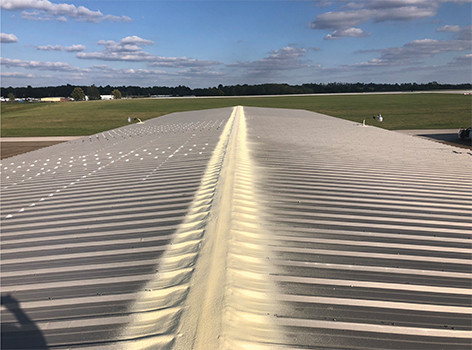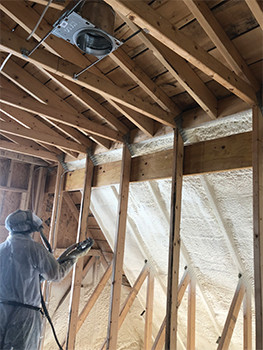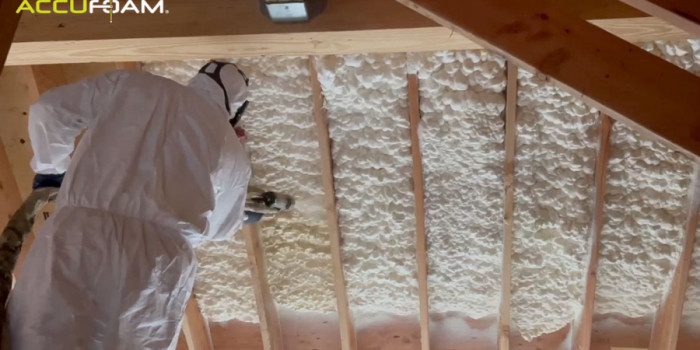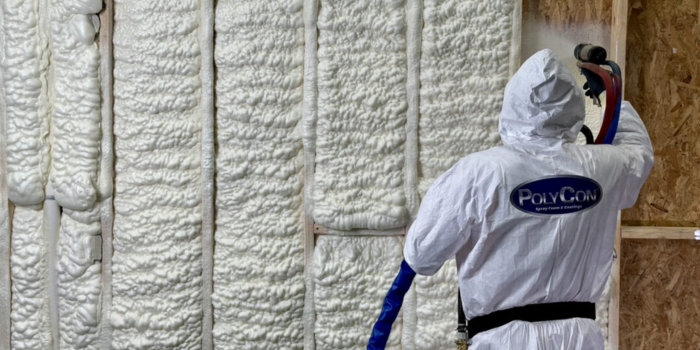Structural Strength


Spray Foam Magazine – Fall Issue 2021 – When insulating a home or a commercial space with spray foam, it is important to understand the types of spray foam insulation and where they are best suited for application. Spray foam insulation is a popular approach to temperature retention and control that helps promote energy savings and lowers costs. However, not all spray foam is equally applicable to any space. Using the wrong type of insulation in a particular location is at best minimally effective, or worse, can introduce new issues.
Closed-cell foams vary from open-cell foams in that they are denser and less porous than open-cell spray foam insulations. This is due to the air pockets that reside within it after formation which is very minimal due to the physical properties of a densely formed cell structure.
Advantages of Closed-Cell Foam Insulation in a building Structure
During application, closed-cell insulation receives a boost in efficiency due to a tight bond and sealed cell structure, resulting in a higher R-value than its open-cell counterpart. The tightly bonded cell structure results in far less permeability of heat or cold, increased structural integrity, as well as a higher water resistance. This makes closed-cell foam insulation a superior choice for insulating exterior walls and roofs, an option not suited for open-cell. As these exterior substrates are exposed to the forces of elements, closed-cell spray foam carries certain advantages.
With an R-value averaging over 6.0, very little air can penetrate the insulation barrier. That promotes excellent surface temperature control when the insulated area is trying to keep heat (or cool) from escaping outside, and from coming in.

Closed-cell foam is ideal for insulating exterior walls and roofs because it's tightly bonded cell structure results in far less permeability of heat or cold, increased structural integrity, as well as a higher water resistance.
Photos provided by SprayworksExterior walls tend to take in significant rainwater. While the walls themselves stave off a lot of the rain, water does find a way in through small crevices. Uninsulated walls, after enough water absorption, can start to experience rot, which in turn, compromises the efficiency of the building material, and over time, can potentially hinder structural integrity. The dense closed-cell foam insulation expands into tight voids in the walls and covers the general area. Water that does get into the walls is therefore limited in how much it can travel, reducing the impending damage it could cause, especially since the spray foam itself does not endure any water damage.

When installed into a space, such as an attic, the closed-cell becomes rigid can can equal the firmness of wood in its consistency, adding an extra layer of structural support.
From a structural perspective, closed-cell foam insulation adds another layer of support to the structures it is used to insulate. When formed and packed into a particular space, the material becomes rigid and can equal the firmness of wood in its consistency. While building codes attend to the structural integrity, more dire events, such as intense wind and other acts of nature can still leave structures compromised. The closed-cell insulation in interior walls provides an extra layer of protection to promote more durability and stability.
Two other commonly overlooked benefits of closed-cell insulation deal with some other things that insulated walls will not let through. One of those is pollen and other external allergens. Small pollination can blow into walls and even move through into homes or offices. With the tight reinforcement of sprayed in place closed-cell insulation, another preventative layer is added. When walls are devoid of insulation, small rodents and other undesirable visitors can burrow their way into them. However, digging through the tightly rigid insulation will divert most of them from trying.
Important Considerations
Spray on closed-cell foams density only permits it to expand by up to three to four inches in a single lift. Unlike the open-cell variety which freely distributes to around eight to 12 inches with expansion, and an R-value of just over half that of closed-cell foam. It also takes less liquid chemical to achieve the same R-value in the same area, causing the application of it to be more costly from a material cost perspective. Depending on the amount of, or even the requirement, with shave off over expanded foam, open-cell foams may be the most cost-effective way to achieve the desired insulation properties.
Due to a higher cost, while closed-cell foam insulation can certainly be applied to interior walls, it is in some cases more efficient to insulate those with open-cell foam. As there is no permeating gas or liquid through interior walls, the biggest achievement with that insulation is soundproofing, a purpose for which open-cell insulation is perfectly effective. Closed-cell insulation is best suited for those situations where moisture and the potential of escaping heat or coolness is an issue.
Disqus website name not provided.










































